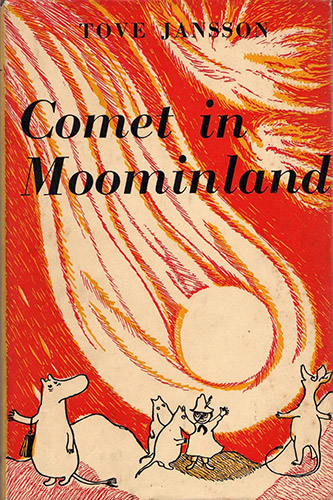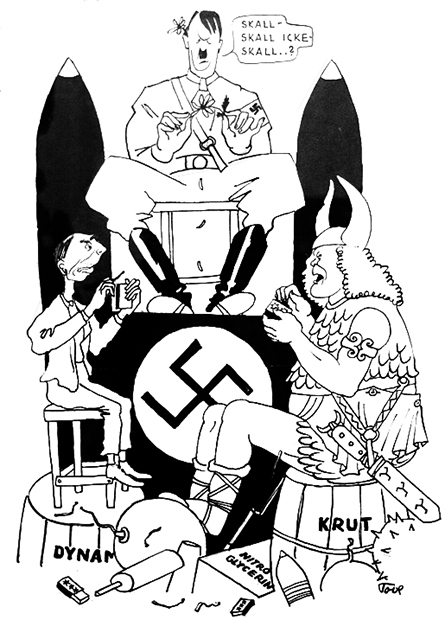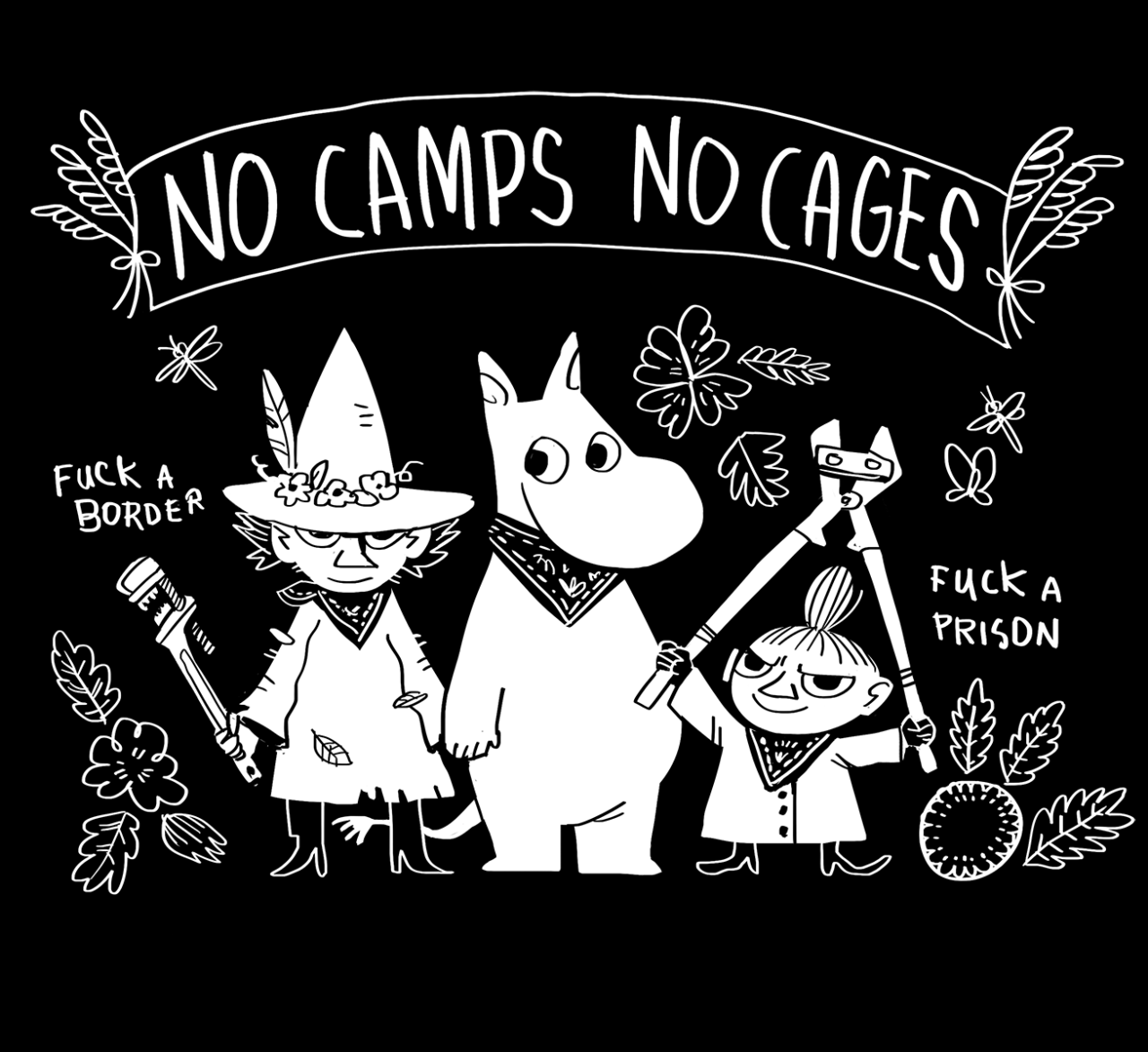

|
|

The History of Tove Jansson and The Moomintroll
Essay — February 2024
In 1914, Tove Jansson was born in Helsinki, Finland to father Viktor Jansson, a sculptor, and mother Signe Hammarsten-Jansson, a graphic artist and illustrator. From the age of 16 to 24, she studied at three different universities for the arts, Konstfack University of Arts, Crafts and Design in Stockholm, Sweden, the Graphic School of the Finnish Academy of Fine Arts in Helsinki, and L'École d'Adrien Holy and L'École des Beaux-Arts in Paris, France. Then, in the 1940s, Tove also began illustrating for Garm, an antifascist political and satirical magazine published in Helsinki. It was during this time, in 1943, she drew a strange creature labeled a "snork." This wasn't her first time drawing the creature, however, this was only its first public appearance. This "snork," in actuality, was designed years earlier in an attempt by Tove to get back at one of her brothers, by going to the outhouse and drawing the ugliest creature she could imagine on its walls. She would write in a letter to a friend that drawing these creatures helped her when she was "feeling depressed and scared" about the state of the world and the loss of life during World War II, with her going "into an unbelievable world where everything was natural and benign" when she wanted to "get away from [her] gloomy thoughts."

The 1920-30s outhouse "snork."
The 1943 Garm illustration with two "snorks" (middle left).
By the time Tove had drawn several different variations of the "snork" for Garm and in other illustrations, the creature had gained another name, "moomintroll," the name of a creature Tove's uncle, Einar Hammarsten, created in an attempt to scare her away from night eating. This name would carry over to the first story Tove would write and illustrate about the creatures, "The Moomins and The Great Flood," published in 1945. In this story, the three primary characters would be Moomintroll, or Moomin; Moominmama, and Moominpapa (whose roles in Moomin's life are self-explanatory). Additional characters include Sniff, a dog-like creature, and the Hattifatteners, which are small ghostlike creatures that travel in large groups.

English Cover of The Moomins and the Great Flood illustrated by Tove Jansson.
The next novel in the world of the Moomins, Comet in Moominland, published in 1946, would establish many more characters, like Snufkin and Snorkmaiden (seeing the reappearance of the word "snork"). And the next after, Finn Family Moomintroll, in 1948, would be the first of these novels translated into English (for this reason, it was often mistakenly cited as the first of the series until the 1980s).


English Covers of Comet in Moominland and Finn Family Moomintroll illustrated by Tove Jansson.
These books would remain relatively confined to audiences in Finland, however, until 1954, when the world’s largest newspaper, London's The Evening News, began to publish the comic strip, reaching 20 million readers daily, in over 40 countries. After this, the Moomin comics would continue to be made until 1974 by Tove, and then would be picked up by her brother and fellow artist Lars Jansson in 1960. 1959 would see the first stage play about the Moomins, and ten years later, in 1969, the first Japanese animated series about the Moomins would air, with Yasuo Otsuka as animation director– who was a key mentor to animator Hayao Miyazaki. Tove, however, found the show distasteful and in strong opposition to the philosophy of the Moomins.
"First of all, the starting point is wrong. That is, the Moomin Valley and the Moomin way of thinking are all expressed differently.
The Moomin family members do not live in today's modern society. They live in a society that is benign and kind. Of course, incidents do occur. The Moomin family likes incidents. However, they never argue. It is unthinkable for Moominpappa to slap his son on the buttocks, and no one in this world slaps anyone on the buttocks. If they do get angry, for example, they will only hit each other's heads with umbrellas and never use force of arms.
Overall, the feeling of the Moomin Valley has been lost. It seems to me that the only way to save this mistake is for everyone involved in this work to read the Moomin books well, to become integrated into the Moomin world, and to feel and understand that feeling."
—Tove Jansson
Later that year, there would be a Swedish-produced TV series that involved live-action actors in costumes, which Tove had a larger part in creating. In 1970, the last Moomin book was published, and Tove focused on her adult writing, publishing her novel The Summer Book. Additional Moomin entertainment would continue to be created in following years, including an opera (1974), a picture book (1977), a Polish stop-motion animated short (1979), illustrations for several humanitarian groups (1980s), a museum exhibit (1987), a second Japanese animated show (1990)– which Tove liked far more than the 1969 show– and a Finnish theme park (1993), before Tove passed away June 27, 2001. Even after, Moomin media continues to be made and dispersed, with the most recent adaptations being an animated show that started in 2019 and a new, Japanese theme park which also opened in 2019. Past The Moomins, in 2020, a biographical film would be released titled Tove– which dramatizes the life and affairs of Tove herself– and in 2023, the Moomin Characters Oy Ltd company (run by Tove's niece, Sophia Jansson,) and the United States-based bookstore chain Barnes & Noble would strike a deal to bring Moomin books and merchandise to the Barnes & Noble online platform and select physical locations across the country.
Past its continuing reach globally, The Moomins and their stories have always been deeply interwoven with the lived experience of their author. Moomin was often tied to Tove herself, and the character of Snufkin was based on a man who, at one time, was her fiance; the political philosopher Atos Wirtanen (this also lends itself to a queer reading of the relationship between the characters, as even after their separation, Tove always held Atos in high regard). However, both in-between splits with Wirtanen and after they had separated, Tove saw multiple female partners, eventually meeting her life partner, Tuulikki Pietilä, in 1956. Tuulikki would inspire the character Too-Ticky in The Moomins books and comics; a wise, boyish woman who was practical and hardworking, a character that could in the modern day be deemed "butch." This would not be the only time Tove would insert a female partner into the world of The Moomins, however, merely the only primary character with this inspiration. Another pair of recurring characters that relate to Tove's queer relationships are Thingumy and Bob, or "Tofslan and Vifslan" in their original Swedish. These names are references to Tove (Tofslan) and the woman she saw before Tuulikki, Vivica (Vifslan) Bandler. In the first appearance of Thingumy and Bob, the gender-ambiguous characters are hiding a secret, and speak a language only decipherable by Snrokmaiden and what she says is a "Woman's Intuition." Despite this, Thingumy and Bob's genders are kept somewhat ambiguous at the time of their debut, as to avoid controversy. For this reason, the characters' pronouns vary in different adaptations and languages. In the English dubbing of the 1970 Polish series, the two characters are referred to with masculine pronouns, again being an interesting way in which Tove’s relationships in life create masculine queerness in The Moomins.
Despite the subtlety of the queerness in The Moomins, Tove never hid her queerness in her personal life, despite homosexuality remaining illegal in Finland until 1971. Though, in Tove's own words, she was never singularly homosexual. She would say that despite her budding relationships with women, her "relationships with men are unchanged," and that she "always fell in love with a person," regardless of gender identity. "Sometimes that person was a man, and sometimes it was a woman, but the important thing was that I fell in love with that person."
Tove Jansson would pass away in June of 2001 at the age of 86, having spent 45 years with her life partner, Tuulikki Pietilä, who would herself pass away in February of 2009, at the age of 92. Tove Jansson would live a long, queer life, one which would continue to inspire queer people long past her death.
Lemon Boy and I, we're gonna live forever
Like Snufkin and Little My, we'll get around wherever."
—Lemon Boy, Cavetown
Her characters would be influential in queer music, such as Lemon Boy by Cavetown, a transmasculine and asexual/aromantic musician. This reference may be what later lead to him getting an original song in the soundtrack for the second season of Moominvalley, along with other queer artists around the world who were featured in the shows soundtrack, like the lesbian singer Alma from Tove's home country of Finland, bisexual singer/songwriter Josef Salvat from Australia, non-binary singer-songwriter Soak from Ireland, pansexual singer Declan McKenna and bisexual singer Dodie from England, and the lesbian artist Girl in Red, from Norway. These were all original songs made by these queer artists for The Moomins, continuing the queer legacy of Tove Jansson. And the fan culture around The Moomins mirrors this, with queer artists, creators, and fans using The Moomins to express that queerness, as well as using the characters in antifascist messaging, a cause Tove herself championed in her work in Garm.

Two modern examples of Moomin fan art leaning into queer themes.


Two of Tove Jansson's Garm covers.


Two modern political illustrations using The Moomin characters.
Tom Morello of Rage Against the Machine wearing an antifascist Moomin shirt
Tove Jansson was an openly queer artist across the span of 7 decades, and whose creations maintain a subtle but widespread impact across the globe. Her story is an interesting window into the topic of gender equity in Finland in her almost 9 decades of life, as well as an example of the cultural impact of female artists in the country. Along with her importance to Finnish history, her story is an important part of queer history internationally.

Tove Jansson at her home.

[Chase Mueller © 2025. Addt'l Credits. ]